|
Visit our keyboard shortcuts docs for details
Geology determines where plants grow, where human beings live, where animals live. It's the foundation of everything in our environment. Learn about how geology shaped Ancestral Pueblo culture and the history of Mesa Verde.
Geology of the Mesa Verde Region
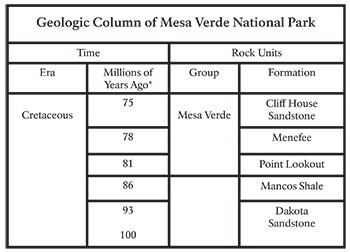
The geological formations of Mesa Verde National Park were mainly deposited when the Western Interior Seaway washed over the mid-section of the North American continent. This sea advanced and retreated many times due to climatic changes during the Cretaceous Period. About 100 million years ago, the sea reached the Mesa Verde area and deposited the Dakota Sandstone. Initially, sand was deposited in a very shallow area of the sea near the beach. The sand was compacted and cemented into sandstone. These rocks form the erosion resistant base of the Montezuma Valley below Mesa Verde, around the city of Cortez. 
The sea advanced farther westward and the sandy tidal deposits changed to deep water deposits. These are shale deposits, which consist of fine particles and organic material. This thick deposit is called the Mancos Shale, which tends to be gray in color. The fossils that can be found in this formation include oysters, clams, small snails, shark teeth, and ammonites, an ancestor of present day mollusks. This shale forms the low hills you see at the base of the mesa in the Montezuma Valley. Places to view Mancos Shale: This formation is best seen from Highway 160 or at the lowest portion of the entrance road.
Above the Mancos Shale is the collection of formations known as the “Mesaverde” Group. The group was actually named by geologists in 1875, well before the designation of the area as a national park. The formations, from oldest to youngest, are as follows: the Point Lookout Formation, the Menefee Formation, and the Cliff House Sandstone.
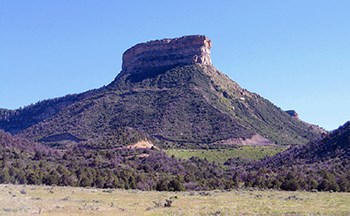
The Point Lookout Formation lies directly over the Mancos Shale. The Point Lookout is mainly composed of tan to buff colored sandstone, with some shale lenses interspersed throughout. At the time of its deposition, the sea was retreating and the water here became more shallow. This caused the change in deposition from shale back to beach deposits of sandstone. Few fossils are found in this formation, but those that are present include crustaceans, clams and ammonites, pieces of driftwood, and palm tree leaves. Small alcoves can form in this sandstone layer, but these were not often used by the Ancestral Pueblo people.
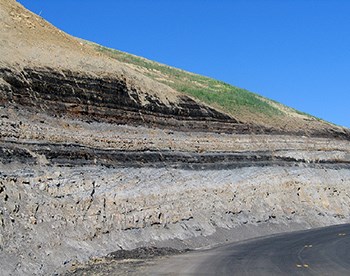
After deposition of the Point Lookout Formation, the sea completely withdrew from this area. A flat, coastal plain emerged just over 80 million years ago. Swamps developed as small, slowflowing streams wound their way to the sea, which was northeast of here at that time. As plant and organic material decayed and accumulated, fine grained shales formed. These shales are often dark brown or black, and are known as the Menefee Formation. Thin beds of sandstones and coal seams can also be found within this formation. Leaf impressions, tree branches and other fossilized plant remains are located in the shales. Places to view Menefee Formation: The Menefee Formation can be seen atop the Point Lookout Sandstone from Geologic Overlook. 
The final formation of the “Mesaverde” Group is the Cliff House Sandstone. It was named as such because this type of sandstone was used by the Ancestral Pueblo people to build their homes and because the cliff dwellings are located within it. The sea advanced yet again and the influx of sand generated the thick, orange-buff colored sandstone. Very few fossils are found in this formation due to tremendous wave and biological action in beach environments, but some have been preserved. These include crustacean burrows, ammonites, clams, and one perfect starfish impression. The wave action also generated ripple marks throughout this unit. The alcoves formed in this sandstone created perfect shelters for the Ancestral Pueblo people, which they occupied throughout the 1200s. Places to view Cliff House Sandstone: Any park overlook of a cliff dwelling offers an excellent view of the Cliff House sandstone.
Deposition by the Western Interior Seaway did not end with the Cliff House Sandstone. Some additional 1500 feet of shale and sandstone was deposited above the Cliff House that has since been removed by millions of years of erosion. After 25 million years of fluctuation, the Western Interior Seaway retreated from this area for the last time about 75 million years ago.
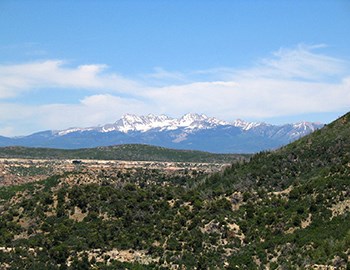

Igneous dikes are located within the park in Navajo Canyon, Mancos Canyon and on Wetherill Mesa. These are magma intrusions that cut vertically upward through the surrounding rocks. The dikes were generated by a much more recent period of volcanism, about 30 million years ago. Places to view dikes: The trace of a dike is visible in Navajo Canyon from the overflow parking lot near the museum, as a steep sided slot cut in the canyon wall.
Without the erosion and downcutting that occurred in the area, the beautiful canyons would not exist. The Ancestral Pueblo people would not have been able to inhabit the cliffs that these canyons created. Their lives were undeniably intertwined with the earth and all of nature surrounding them. If not for the amazing combination of geological processes at work here, the people never would have made Mesa Verde their home. 
Geologic Features of the Park

The 7° (degree) angle of Mesa Verde is essential to the formation of the alcoves. Alcoves are large, arched recessions formed in a cliff wall. (An alcove is not the same as a cave. Caves are underground chambers, which are not found in Mesa Verde.) The majority of alcoves within Mesa Verde are small crevices or ledges able to accommodate only a few small rooms. Very few are large enough to house a dwelling the size of Cliff Palace, at left. But alcoves have protected the cliff dwellings for centuries and largely contribute to their spectacular preservation. 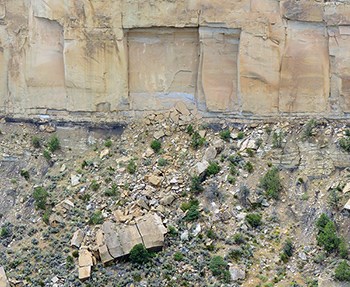
The rock surrounding the cliff dwellings is primarily Cliff House Sandstone. Since sandstone is a very porous material, moisture from precipitation seeps into it and gravity carries it downward through the rock. Beneath the layer of sandstone, however, is a layer of shale through which the moisture cannot penetrate. Water is in constant contact with the sandstone in these areas and dissolves the calcium carbonate that holds the sandstone together. In winter months, when moisture within the rock freezes and expands, chunks of sandstone crack and loosen. These pieces eventually collapse, fall off in blocks, and over time, form alcoves. Pieces of sandstone, created during the formation of alcoves, were shaped and used by the Ancestral Pueblo people to construct their homes. 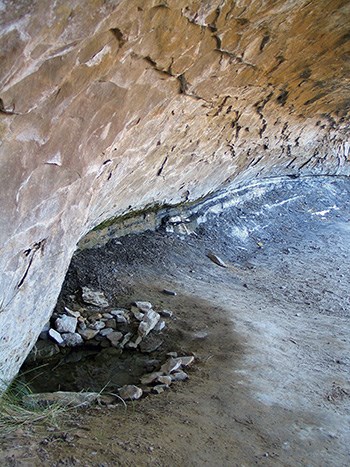
Alcove formation is assisted by water that is absorbed into and percolates through pores in the sandstone. The water eventually reaches a layer of shale, which is much less porous, or absorbent, than the sandstone. The water cannot easily pass through the shale, and so gravity guides it along the top of this layer to the cliff face. Seep springs are found where the water emerges from the cliff face, directly above the shale layer. Seeps provided a continuous source of water for the Ancestral Pueblo people for at least 750 years. The water within the rock is in constant contact with the sandstone in these areas and dissolves the calcium carbonate that holds the sandstone together. Eventually this causes the sandstone to fall apart and crumble into individual grains of sand. The grains are washed away during rainstorms or blown away by the wind. This silt and sand were used by villagers as part of their mortar mix. A side view of alcoves reveals they are c-shaped. This made it necessary for the ancient builders to backfill the floors of alcoves to obtain a flat surface for construction of their homes. The process of alcove formation continues today, which is one reason that stabilization work is an important part of the preservation efforts at Mesa Verde.
Places to view alcoves: The largest alcoves at Mesa Verde contain cliff dwellings, and can been seen at Cliff Palace, Hemenway House, Spruce Tree House, Long House, and Step House. 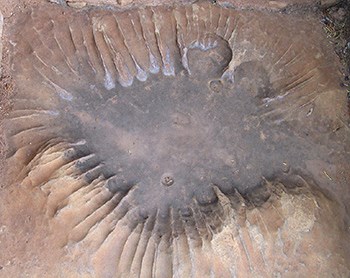
Solution rills are an interesting feature within the park. Natural depressions in the sandstone form because acidic rain dissolves the calcium carbonate that holds sandstone together. The depressions deepen as small grooves develop along the paths that the water follows into the depressions. Eventually a flower pattern can result, as the ridges between the grooves grow upward from the deposition of minerals along them. Archeologists have speculated that these rills held a special importance for the Ancestral Pueblo people. Places to view solution rills: Solution rills can be seen in a niche at Sun Temple on the Mesa Top Loop and at the House of Many Windows Overlook. 
Concretions are hard, compact masses of minerals that form within a pre-existing rock. These nodules are often spherical, elongate like a pipe, and are usually harder than the rocks that contain them. They develop around an irregularity within the rock that serves as a nucleus, often a piece of shell, a pebble, or just a harder spot in the rock. As water runs through the rock, it deposits minerals at these irregular spots. Most of the concretions in Mesa Verde are in the Cliff House Sandstone or the Point Lookout Formation, and are composed of iron oxide or calcium carbonate. Places to view concretions: There are well developed concretions located at the Spruce Tree House overlook. 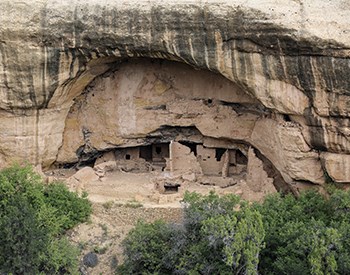
On many of the cliff faces, vertical streaks of dark brown or black can be seen. This is called desert varnish. It is different than the blackening of the roofs in the alcoves, which was darkened by smoke from cooking fires. Desert varnish forms when manganese, a mineral found either within the rock or in windblown dust, is fixed to the cliff face by bacteria. The bacterial action occurs on the portions of rock that are wet from runoff water, which causes the streaking effect. Places to view desert varnish: This feature is visible around almost every alcove in the park, but can be seen in abundance from the overlooks on the Mesa Top and Cliff Palace/Balcony House Loop Roads. 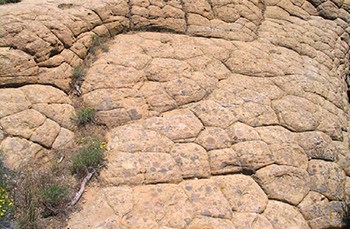
A distinctive feature called turtle back weathering develops in the Cliff House Sandstone that is exposed and unprotected on mesa tops. Originally, there was about 1500 feet (457 m) of rock atop the Cliff House Sandstone. As this overlying rock eroded away, it released a tremendous amount of pressure on the sandstone. The pressure release caused cracks to form in the rocks. Water then weathered these cracks through freezing and thawing, or by dissolving the calcium carbonate that holds the sandstone together. Erosion cut down into the cracks and rounded the top of the rock, causing the pillow like or turtle shell appearance.
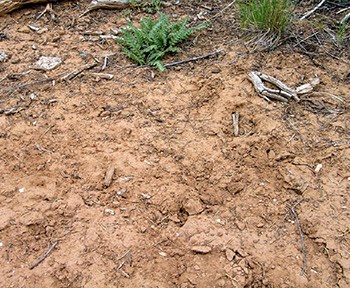
The mesa top is blanketed by a red soil called loess. Loess is a deposit of very fine silt, which is transported by the wind from dry regions. The loess at Mesa Verde was blown in by southwesterly wind for the past one million years. The soil is very rich and holds moisture, thus is a perfect medium for agriculture. The large pinyon and juniper trees are evidence of the soil's fertility. The Ancestral Pueblo people recognized it as ideal farmland and planted on the mesa tops where the loess is 3 to 30 feet (0.9 to 9.2 m) deep. When the people cut down trees for building and firewood, this left the bare loess vulnerable to erosion and made it difficult to farm in those areas. A reduction in viable farmland could have contributed to the migration of the people from this region, although the construction of check dams may have helped alleviate some of this problem. Places to view loess: The red loess of Mesa Verde is plentiful on the Mesa Top Loop Drive and along most of the park trails. 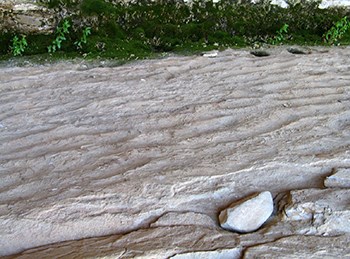
Ripple marks in the park are evidence that this area was once covered by a vast inland sea. These ridges of sand resemble ripples in water and form on a surface where sediment is deposited. They were preserved in the sandstone as more sediment was deposited on top of the ripple marks, causing compaction and consolidation of the sediment into rock. The people here must have wondered how such a distinctive mark of water ended up in the rocks. Places to view ripple marks: Very symmetrical ripple marks can be found after the seep spring in the back of Long House. 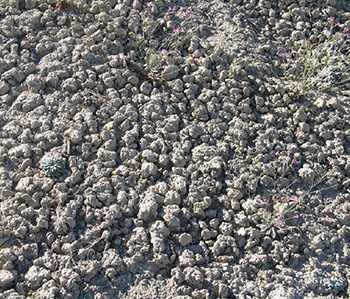
An interesting feature develops in the Mancos Formation as the soil fluctuates between wet and dry periods. It shrinks and swells with a change in water content, resulting in a popcorn texture. It is very similar to the way mud cracks as it dries, but in soils with high clay content, the swelling causes the surface to look like popcorn. The clay content is most likely bentonite, a type of clay that forms from the weathering of volcanic ash. Popcorn texture is common in badland areas, such as the Big Badlands of South Dakota. The hills formed by Mancos Shale have this badlands-like topography. Places to view popcorn texture: Popcorn texture is visible along the main road at the base of the low gray hills just after the entrance station to the park, next to the first pullout on the west side of the road. 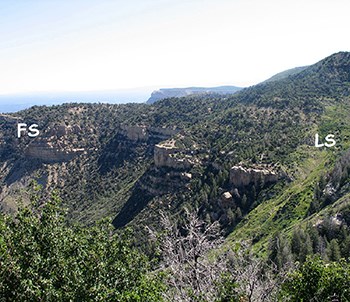
Several small faults occur within the park boundaries along the mesa's North Escarpment. The northern section of rock of the fault pictured dropped down about 20 feet (6 m) relative to the southern section of rock. There have not been any earthquakes reported from epicenters within the park since historical record keeping began in the 1870’s, which indicates that these faults are no longer active. Landslides are a regular occurrence in the area. The shale of the Mancos and Menefee Formations are very unstable because they weather so easily. This makes regular construction and maintenance of the roads necessary. Places to view faults and landslide scars: Both of these features are visible from the Geologic Overlook. Geology of Mesa Verde was created in cooperation with the GeoCorps America Program, which is sponsored by the Geological Society of America. NPS Geodiversity Atlas
|
Last updated: April 21, 2025
